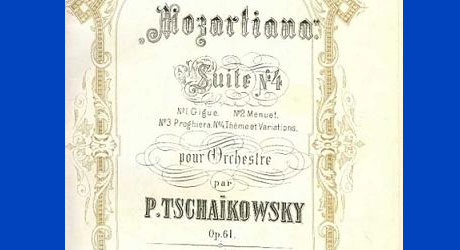Tchaikovsky doesn’t sound much like Mozart. The Russian composer wallowed in Romantic angst, unlike his self-confident musical predecessor from the Classical period a century earlier. Nonetheless, Peter idolized Wolfgang. The Mozartiana is Tchaikovsky’s homage to the Master on the occasion of the 100th anniversary of Mozart’s opera Don Giovanni. Exposure to that opera as a child sparked Tchaikovsky’s entire musical career.
By serendipity, Tchaikovsky had a chance to view the original score of his favorite opera, owned by an acquaintance in Paris, the year before he composed Mozartiana. He used religious terminology when he wrote about handling the manuscript in a letter to his patroness, Nadezhda von Meck: “I cannot describe the feeling which came over me when I looked through this musical holy of holies.”
Tchaikovsky didn’t just admire Mozart’s music, but revered Mozart, the person, as a genius and an ideal human being. In another letter to his patroness, who did not share his enthusiasm for Mozart, he described his hero as having “a wonderful, irreproachable, infinitely kind, and angelically pure nature… He was the incarnation of the ideal of a great artist who creates because of an unconscious stirring of his genius. He wrote music as the nightingales sing, i.e. without pausing to think, without doing violence to himself…Everyone loved him; he had the most marvelous, cheerful, and equable temperament. There was not a whit of pride in him… The purity of his soul was absolute. He knew neither envy nor vengefulness nor spite, and I think that all this can be heard in his music, which has reconciling, clarifying, and caressing properties.” In other words, Mozart’s putative flawless character was everything that the self-tortured Tchaikovsky’s was not, but that he yearned for.
For his Mozartiana Tchaikovsky didn’t dare borrow themes from the opera that occasioned the tribute or any of Mozart’s most important works. Instead, he decided to borrow lesser themes, hoping to avoid the charge of hubris for rewriting masterpieces in a contemporary idiom. Instead, he hoped people would see him as drawing attention to overlooked gems. Or something like that. Tchaikovsky is known for brooding emotion rather than cold logic.
The piece was written during a stay with his younger brother Anatoly in Tiflis, now known as Tbilisi, in Georgia. Originally, Tchaikovsky had intended to translate the libretto of Don Giovanni and collaborate on an essay on the composer he so venerated as well, but only the Mozartiana was completed.
Tchaikovsky viewed it as merely an orchestration or arrangement of the original Mozart pieces. “In the course of the orchestration I made minute enhancements and modifications to the harmony,” the composer wrote to his publisher. The original Mozart pieces were for piano, excerpt for the basis of the third movement, which was originally a motet (sacred choral piece for several voices). But the great Hungarian pianist and composer Franz Liszt had transcribed the motet for piano, and Tchaikovsky worked from the secondary source. And for the fourth movement, a Theme and Variations for piano, Mozart had borrowed a theme from a very silly comic opera by Gluck, The Pilgrimage to Mecca.
You might forgive a listener unable to recognize the Mozart in Tchaikovsky’s rendition. It sounds more like The Nutcracker than like Eine Kleine Nachtmusik. While most of the scoring is consistent with an orchestra from Mozart’s day, Mozartiana sounds richer and lusher than anything Mozart might have been familiar with. Tchaikovsky expands the percussion section (listen for the Glockenspiel in the final movement) and adds a heavenly harp to the third movement, Pregheira (Prayer). Yet some of the classical purity shines through, especially in the first two movements.
The first movement is a jig [Gigue], marked Allegro (fast and happy), from Mozart’s Eine kleine Gigue for piano (KV 574).
The second movement is a court dance, Minuet [Menuet], marked Moderato, from Mozart’s Menuett for piano (KV 355).
The third movement, Prayer [Pregheira], is marked Andante non tanto (slower but not too much—walking tempo), after Mozart’s motet Ave Verum Corpus (KV 618) in a transcription for piano solo by Franz Liszt.
The final movement showcases solo talent from throughout the orchestra, especially the principal violin. It is a Theme and Variations [Thème et variations] with the tempo marking Allegro giusto (truly fast and happy, with energy) from Mozart’s Ten Piano Variations on a Theme by Gluck, K. 455.
All four movements together add up to about 25 minutes of playing time, with more than half of that of that devoted to the last movement. Ballet lovers may find Mozartiana familiar, as George Balanchine choreographed it in 1981, although he reshuffled the order of the movements.
Notes by Emily S. Plishner
Orchestral Suite No. 4 in G Major
Op. 61, "Mozartiana"
Composed in 1887
By Pyotr Ilyich Tchaikovsky






